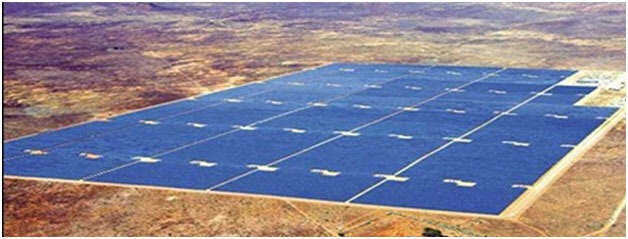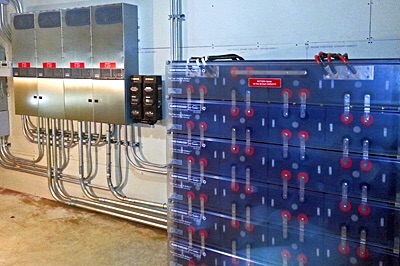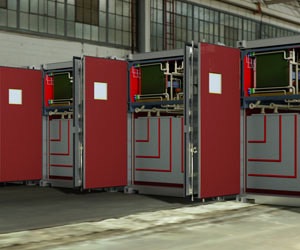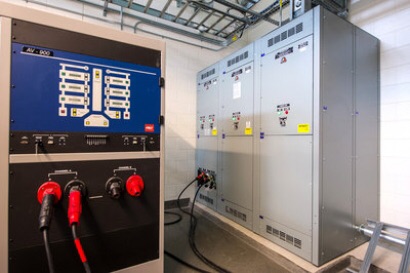|
JOIN OUR MAILING LIST |
|
5. Global Gazette 2015-01-12 Solar FAQ's //s.kwikweb.co.za/solarenergy/photos/Solar FAQs.pdfEdited/Compiled by: Solar FAQs Jeff Tsao (U.S. Department of Energy, Office of Basic Energy Science) Nate Lewis (California Institute of Technology) Abstract We ask and answer a series of questions regarding the potential of the sun to supply energy to the world. The questions are drawn in large part from the U.S. Department of Energy Office of Basic Energy Science’s recent report on Basic Research Needs in Solar Energy Utilization (BES 2005). The answers are given in a format suitable for a lay technical audience, and are supplemented by detailed calculations and comprehensive references.a Questions
a Please send technical comments and suggestions for additional questions to: Jeff Tsao (Jeff.Tsao@science.doe.gov). We acknowledge contributions and comments from: Mark Spitler, Randy Ellingson and Harriet Kung (Office of Basic Energy Sciences); Art Nozik and Ralph Overend (National Renewable Energy Laboratory); Jeff Mazer (Office of Energy Efficiency and Renewable Energy); and Mike Coltrin and Charles Hanley (Sandia National Laboratories). Working Draft Version 2006 Apr 20 Solar FAQs Page 1 of 24 1. How much energy will the world need in the coming century? The most widely used scenarios for future world energy consumption have been those developed by technical experts brought together by the Intergovernmental Panel on Climate Change (IPCC), an organization jointly established by the World Meteorological Organization (WMO) and the United Nations Environment Programme (UNEP). A scenario from their most recent set of scenarios is outlined in the last two columns of Table 1. Though this scenario should not be thought of as any more probable than others in their set, it is based on “moderate” assumptions, and hence can be viewed as neither overly conservative nor overly aggressive. To better understand this scenario, the top half of Table 1 lists, as is traditional, the fundamental factorsb that the world energy consumption rate, (1) Ä– = N · (GDP/N) · (Ä–/GDP), is the product of: N is world population, GDP/N is world per capita GDP, and Ä–/GDP is world energy intensity (energy consumption rate per unit of GDP). By breaking Ä– apart in this manner, one can see more clearly how it increases (or decreases) as its fundamental factors increase (or decrease). In particular, world population was approximately 6.1 billion in 2001, and in the Table 1 scenario is projected to increase by 0.9%/yr to approximately 9.4 billion by 2050. World per capita GDP was approximately $7,500 in 2001, and in the Table 1 scenario is projected to increase by 1.4%/yr to approximately $15,000 by 2050. World energy intensity was approximately 0.29 W/($/yr) in 2001, and in the Table 1 scenario is projected to decrease by 0.8%yr to approximately 0.20 W/($/yr) by 2050. Putting these projections in the fundamental factors back into Equation (1) gives a world energy consumption rate projected to more than double, from 13.5 TW in 2001 to 27.6 TW by 2050, and then to more than triple to 43.0 TW by 2100.
Table 1: World Energy Statistics and Projections. We emphasize that these projections have large uncertainties.c Nevertheless, they are reasonable, and represent a concrete starting point for framing the magnitude of other issues that follow. b This factorization stems from the so-called IPAT (impact = population · affluence · technology) relationship discussed in Kates (2000), and originally developed by Commoner (1972) and Erhlich (1972). Working Draft Version 2006 Apr 20 Solar FAQs Page 2 of 24 2. What does this projected energy consumption rate imply for the CO2 emissions rate? The projected carbon emissions from the world energy consumption scenario just discussed are also outlined in Table 1. To better understand this emissions scenario, the bottom half of this Table lists, as is traditional, the fundamental factorsd that the world carbon emission rate, (2) ÄŠ = Ä–·(C/E), is the product of: Ä– is the world energy consumption rate (itself the product of fundamental factors through Equation 1) and C/E is the world carbon intensity (carbon emitted per unit energy consumed). One sees from this factorization that, given a world energy consumption rate, the world carbon emissions rate is determined by the world carbon intensity. In particular, world carbon intensity was approximately 0.49 kgC/(W·yr) in 2001, and in the Table 1 scenario is projected to decrease to 0.40 kgC/(W·yr) by 2050 and 0.31 kgC/(W·yr) by 2100. e This projection, combined with the projected world energy consumption rate discussed in FAQ 1, implies that the world carbon emissions rate is projected to increase from 6.6 GtC/yr in 2001 to 11.0 GtC/yr by 2050 and to 13.3 GtC/yr by 2100. We emphasize again that these projections have large uncertainties.f Nevertheless, they are reasonable, and represent a concrete starting point for framing the magnitude of other challenges that follow. 3. What does this projected CO2 emissions rate imply for the atmospheric CO2 concentration? The earth’s CO2 can be roughly thought of as residing in two reservoirs: one large (the atmosphere, the terrestrial biosphere, and the shallow ocean), and one very large (the deep ocean). Within the first reservoir, exchange of CO2 between the atmosphere, the terrestrial biosphere and c The uncertainty due to the assumed projected decrease in energy intensity is particularly large. At one extreme, if energy intensity were to decrease at 2.3%/yr, the increase in population and per capita GDP would be completely offset, and the world energy consumption rate would remain at 13.5 TW. At the other extreme, if energy intensity were not to decrease at all, the increase in population and per capita GDP would cause the world energy consumption rate to increase to 13.5 TW · 1.02283(2050-2001) = 40.8 TW by 2050. The Table 1 scenario assumes the energy intensity will decrease at a rate similar to its rate of decrease over the past 100 years, or 0.8%/yr. This decrease offsets partially, but by no means fully, the increase in population and per capita GDP. d The factorization implied by the combination of Equations 1 and 2 is known as the Kaya identity (Kaya 1990). Working Draft Version 2006 Apr 20 Solar FAQs Page 3 of 24 the shallow ocean is relatively fast -- equilibration occurs on a time scale of years to decades. Between the first and second reservoirs, exchange of CO2 is relatively slow -- equilibration occurs on a time scale of centuries to millennia. Over geological time scales, the two reservoirs are typically assumed to have come to long- term equilibrium with each other. Though atmospheric CO2 concentrations have fluctuated from 170 ppmv to 300 ppmv over the last 420,000 years (Petit 1999), they have been relatively constant at 280 ppmv over the last 1,000 years up until as recently as 1750 (Houghton 2004, Figure 3.2b). However, an additional source of CO2, such as the CO2 emissions discussed in FAQ 2, can disrupt this equilibrium. CO2 emissions entering the atmosphere will increase the CO2 concentration in the first reservoir, which in turn will drive a CO2 flux into the second reservoir. A simplified rate equation that describes this is: (3) Ä‹1 = j - [c1-c2]/τ12. Basically, the rate at which the concentration in the first reservoir increases (Ä‹1) is the difference between the CO2 emissions into the first reservoir (j) and the equilibrating flux of CO2 out of the first reservoir and into the second reservoir ([c1-c2]/τ12, where τ12 is the time scale of equilibration between the two reservoirs). Assuming the second reservoir is much larger than the first reservoir, so that c2 is essentially constant, a steady-state (Ä‹1 = 0) is eventually reached in which CO2 emitted into the first reservoir is exactly balanced by the CO2 flux into the second reservoir. Because the exchange of CO2 between the two reservoirs is slow (the time constant τ12 for equilibration is long), the increase in the atmospheric CO2 concentration necessary to drive this balancing CO2 flux (c1-c2 = jτ12) is large. Indeed, computer models indicate that a 1-2 GtC/yr CO2 emissions rate would be balanced if the atmospheric CO2 concentration were to double, from 280 ppmv to roughly 550 ppmv (Wigley 1996). Conversely, to limit the atmospheric CO2 concentration to 550 ppmv would require, in the long term, a CO2 emissions rate less than 1-2 GtC/yr. Instead, the CO2 emissions rate in 2001 was already much larger than this: 6.6 GtC/yr. Assuming approximate linearity, such a 6.6 GtC/yr CO2 emissions rate would be driving the atmospheric CO2 concentration to quintuple, from 280 ppmv to roughly 1,470 ppmv. It is widely believed (Wigley, 1996) that it is this driving force that has caused the recent observed increase in atmospheric CO2 concentration from its pre-1750 value of 280 ppmv to its 2001 value of 371 ppmv (Keeling 2004). 4. How much future power will need to be “C-neutral,” if the atmospheric CO2 concentration is to be stabilized? The increased atmospheric CO2 concentration discussed above can, through the greenhouse effect, cause an increase in the mean global temperature. Estimates vary, however, for the permissible atmospheric CO2 concentration that would limit the mean global temperature to a safe value. There is uncertainty both in the models used to connect atmospheric CO2 concentration to mean global temperature, and in the mean global temperature that is considered “safe.” In one intermediate (neither overly conservative nor overly aggressive) estimate, an atmospheric CO2 concentration of 550 ppmv avoids many of the “worst” impacts of global warming (Arnell 2002). The long-term implication of stabilization at this atmospheric CO2 concentration, as discussed in FAQ 3, is that the CO2 emissions rate must be limited to 1-2 GtC/yr. The short-term implication is that the CO2 emissions rate should at minimum be stabilized against increases beyond its 6.6 GtC/yr value in 2001. Such a stabilization requires that future Working Draft Version 2006 Apr 20 Solar FAQs Page 4 of 24 increases in energy consumption rate derive almost entirely from zero-carbon-intensity (C-neutral) energy sources that emit no CO2 (Hoffert, 1998). Hence, in round numbers, by 2050 nearly 15 TW, and by 2100 nearly 30 TW, would need to derive from C-neutral energy sources. This implies producing more C-neutral power by 2050 than was produced from all energy sources combined in 2001. 5. What are the consequences of delaying deployment of C-neutral power? As discussed above, the time constant for equilibration between the two reservoirs (the one comprising the atmosphere, the terrestrial biosphere and the shallow ocean, and the other comprising the deep ocean) is very long (centuries to millennia). Hence, the short-term (50-100- year time scale) effect of CO2 emissions on atmospheric CO2 concentration is to a good approximation cumulative.g If during one short-term time period the CO2 emissions rate is higher than the long-term rate (1-2 GtC/yr) for which the atmospheric concentration would be “safe” (550 ppmv), then during another short-term period the CO2 emissions rate must be lower. Since the emissions rate of 6.6 GtC/yr in 2001 was already higher than 1-2 GtC/yr, one can see that stabilizing that emissions rate against further increases, as discussed in FAQ 4, is a “bare minimum” response. An emissions rate of 6.6 GtC/yr for just 15 years would require a decrease to an emissions rate of 0.6 GtC/yr for the following 85 years. Or, an emissions rate of 6.6 GtC/yr for 50 years would require a decrease to an emissions rate of 0 GtC/yr for the following 170 years. In other words, the longer the delay in deploying C-neutral energy, the more C-neutral energy will be needed later to offset the interim CO2 emissions from non-C-neutral sources. 6. Could 15 TW of C-neutral power be derived from fossil fuels? Yes, but only if the huge amount of CO2 generated is sequestered. Suppose fossil fuels were to supply 15 TW of C-neutral power with an aggregate carbon intensity as low as that of natural gas (the least C-rich fossil fuel). Then, the carbon emission rate would be 7 GtC/yr,7 and the CO2 emission rate would be 25.8 GtCO2/yr.8 Over the course of a year, the mass of CO2 emitted would be 25.8 GtCO2, and would occupy, at the standard temperature and pressure of 77 ÌŠF and 1 atmosphere, a volume9 (13,200 km3) greater than that (12,100 km3) of Lake Superior (Great Lakes 2001). This amount of CO2 has also been estimated10 to be: roughly 600 times that injected every year by the U.S. into oil wells to spur production; roughly 20,000 times that stored annually in Norway's Sleipner offshore reservoir; and roughly 100 times the volume of natural gas the industry draws in or out of geologic storage in the U.S. each year to smooth seasonal demand. Over the course of 50-150 years, the mass of CO2 emitted would be 2,000-3,000 GtCO2. This mass of CO2 is comparable to current estimates of technical storage capacity (available global capacity using known technology or practices) in geological formations (IPCC CSS 2005, p. 12). It is also within a factor 3x (IPCC CSS 2005 p. 280) of current estimates of the mass of CO2 that can be stored in the deep ocean at equilibrium with the atmospheric concentration of 550 ppmv discussed in FAQ 4. Beyond finding volumes for storage, those volumes must not leak, otherwise CO2 emission would only be postponed. Even a globally averaged leak rate as low as 1%/yr would only g In Equation (3), at early times, c1 has not had time to deviate significantly from c2, so [c1-c2]/τ12 is roughly zero. Then,Ä‹1≈jandc1≈∫jdt. Working Draft Version 2006 Apr 20 Solar FAQs Page 5 of 24 postpone emission by less than a century, far too short a time to have a lasting impact on atmospheric CO2 concentrations. 7. Could 15 TW of C-neutral power be derived from sources that produce electricity? Yes, but it will be more difficult for them to be cost-competitive. Though electricity is convenient for many uses, its production from fossil fuels and its subsequent long-distance transport are relatively inefficient. It represents a “high-grade” form of energy more expensive by about 3x (per unit of stored energy) than “low-grade” non-electrical forms of energy, such as natural gas used for heating or gasoline used for vehicle transport. Hence, a potential source of electricity faces two different levels of cost-competitiveness. To be cost-competitive with low-grade non-electrical energy, it must be, in current prices, roughly $0.02/kWh; to be cost-competitive with high-grade electrical energy, it need only be, in current prices, roughly $0.06/kWh. Since the world consumes much more low-grade non-electrical energy (80%) than high-grade electrical energy (20%) (IEA WEO 2002, pp. 66-67) a potential source of 15 TW of C-neutral general-use electricity must be cost-competitive with low-grade non-electrical energy (again, in current prices, roughly $0.02/kWh). Moreover, for many potential sources of C-neutral electricity (e.g., far-from-shore harvesting of photovoltaic, wind or ocean-wave energy), long-distance transport of the generated electricity is nearly impossible. For these sources, the electricity would need to be converted into a transportable chemical fuel (e.g., hydrogen or ammonia), incurring an additional 1-3x in cost. Hence, for these potential sources to supply 15 TW of C-neutral energy, the intermediate electricity they generate would need to be 1-3x less expensive still (in current prices, roughly $0.01/kWh). 8. What are some of the challenges associated with supplying 15 TW of C-neutral nuclear power? At the beginning of 2005, there were some 440 commercial nuclear power plants operating in 31 countries, with roughly 364 GWe of total capacity (WNA 2005). Hence, to produce 15 TW (15,000 GWe) by 2050 would require roughly 14,636 new 1-GWe nuclear power plants. Construction of this number of plants would require,11 on average, the commissioning of a new nuclear power plant somewhere in the world every day continuously for 40 years. Assuming the continued dominance of slow-neutron nuclear power technologies,h each 1 GWe plant would require about 195 tU/yr (WNA 2001), so 15 TWe would consume about 2.9 MtU/yr.12 At this rate, the estimated global conventional uranium terrestrial resources (17.1 MtU) (NEA 2002) would be exhausted in less than 10 years.13 Estimated amounts of U from unconventional resources (particularly seawater) are much larger (4,022 MtU) (NEA 2002), but would require a significant physical infrastructure to extract. At a uranium concentration in seawater (Garwin 2001, p. 210) of roughly 3.3 mgU/m3, extracting uranium at a rate of 2.9 MtU/yr would require treatment of water at a volume rate of 886,000 km3/yr,14 more than 4,000 times the volume rate of water (180 km3/yr) through the Niagara Falls,15 and more than 30 times the volume rate of water (23,560 km3/yr) necessary to cool the nuclear power plants.16 h This is the only nuclear technology that is at present “proven” and able to be constructed and brought on line in the needed time period and at the needed scale. Working Draft Version 2006 Apr 20 Solar FAQs Page 6 of 24 Of course, fast-neutron (breeder) nuclear power technologies, if made economical and available worldwide, would alter these scenarios substantially, as they generate more fuel than they consume (Garwin 2001). 9. What are the theoretical, extractable and technical potentials of the various renewable energy resources? All the commonly considered renewable energy resources (hydro, ocean, wind, geothermal, solar) are C-neutral. They have widely differing potentials, however, for supplying massive amounts (of order 15 TW) of power. In the leftmost three columns of Table 2 we gather together order-of-magnitude estimates of their “theoretical,” “extractable” and “technical” potentials. By theoretical potential, we mean the steady-state rate at which the energy resource is being dissipated (and hence being naturally replenished from its primary source). By extractable potential, we mean the useful power after harvesting and conversion into transportable chemical fuel, regardless of technological difficulty. By technical potential, we mean the useful power after harvesting and conversion into transportable chemical fuel, given current or soon-to-be- current technology. Theoretical Potential. In estimating the theoretical potential, we use the following approach, similar to one that has been used previously for ocean tidal energy (Isaacs 1980). In this approach, each of the renewable energy sources is considered a reservoir which is: (a) being filled from some source of primary energy (e.g., the earth-moon gravitational system for ocean tidal energy); and (b) being emptied by a combination of human harvesting (e.g., the 240 MW ocean- tidal-energy-harvesting electricity generating station at La Rance, France) and dissipative processes (e.g., frictional heat as water flows in response to gravitational forces). In the absence of significant human harvesting (the current situation), the steady-state filling rate is equal to the emptying rate due to dissipative processes (e.g., the roughly 2.4-ms-per- century lengthening of the day (Lowrie 1997) is a measure of the primary energy transferred from the earth-moon gravitational system to compensate for the 2.4 TW of ocean tidal “friction” (Egbert 2000)). In the presence of significant human harvesting it is difficult to know how these two rates would adjust. If, however, one assumes that the filling rate stays constant, while the emptying rate simply shifts from dissipative processes to human harvesting, then the filling rate is the highest sustainable human harvesting rate, and is what we assume here to be an order-of- magnitude estimate of the theoretical potential. Note that though the steady-state dynamics associated with the filling and emptying of the reservoirs can be treated similarly for the various energy sources, the type of energy in the reservoirs can be very different (e.g., chemical, electrical, photonic, mechanical, thermal). To call attention to this, we have appended, in the leftmost column of Table 2, subscripts to the units of power (TWc, TWe, TWp, TWm, TWt), in an extension of the common usage for the units TWe and TWt. Extractable Potential. In estimating the extractable potential, we assume that we are interested not in small amounts of power for niche uses, but in massive amounts (of order 15 TW) of power for general use. Hence, the energy must ultimately be convertible into a chemical form that can be transported long (trans-continental and trans-oceanic) distances. Therefore, in estimating the extractable potential of an energy source, we multiply the theoretical potential by an estimated efficiency of this conversion process. To call attention to this, we use units of “equivalent chemical fuel” power (TWc). If the energy is already in chemical form (e.g., solar fuel), then there is no conversion. If the energy is in electrical form (e.g., solar electricity), then we assume a 75% efficiency associated Working Draft Version 2006 Apr 20 Solar FAQs Page 7 of 24 with a conversion to chemical form.i If the energy is in mechanical form (e.g., wind power), then we assume a 33% efficiency associated with a conversion to electrical form (Merriam 1978), followed by a 75% efficiency associated with a conversion to chemical form, for a 25% lumped efficiency. If the energy is in heat form (e.g., ocean thermal power), then we assume a 1-Tl/Th Carnot (second law of thermodynamics) efficiency for a conversion into mechanical form (e.g., rotary motion of a turbine), followed by a 33% efficiency for a conversion from mechanical to electrical form (NG 2004), followed by a 75% efficiency for a conversion from electrical to chemical form, for a (1-Tl/Th)·25% lumped efficiency. Technical Potential. In estimating the technical potential, we assume that we are interested in the power that can be harvested from geographical areas of the earth reasonably accessible using current (rather than speculative future) technologies. Therefore, in estimating the technical potential of an energy source, we do not include that portion of the extractable potential not enabled by current technologies. For example, we assume current technology precludes extraction of energy over the deep ocean; hence technical potentials are much lower than extractable potentials for all the ocean energy resources except salinity gradient. Note that as technology evolves (e.g., the development of massive floating platforms over the deep ocean), technical potentials will surely increase, but presumably they will not surpass the extractable potentials. Also note that the full technical potential is not necessarily economical to extract. We do not list here the economic potentials, although the 2001 supplies are perhaps a rough indication of these. Finally, note that we have also not taken into account possible adverse environmental impact associated with harvesting the various energy resources (for example, harvesting all the wind energy in a particular geographical zone could have undesirable consequences on local climate). These consequences are difficult to estimate, but the “environmentally benign” technical potentials would surely be at least somewhat less than the listed technical potentials. 10. Which renewable energy resources have the greatest potential for supplying 15 TW of C-neutral power? As can be seen from the leftmost three columns of Table 2, the potentials for the various renewable energy sources vary widely. There are four sources with theoretical potentials exceeding 15 TW: solar, wind, geothermal, and ocean waves. There are only two sources, however, with extractable potentials exceeding 15 TW: solar and wind. Though geothermal has significant theoretical potential, its extractable potential is much less because it is mostly in the form of “low-grade” heat, with low conversion efficiency into chemical fuel. Also, though ocean waves has significant theoretical potential, its extractable potential is much less because it is in the form of mechanical power, with low conversion efficiency into chemical fuel. Finally, there is only one source with technical potential safely exceeding 15 TW: solar. Though wind has significant extractable potential, its technical potential is much less, in large part because much of its power resides geographically over the relatively inaccessible deep oceans. The same is true for solar, but because its extractable potential is so huge its land-based technical potential remains large. i The technology for electrolysis of water to form hydrogen and oxygen was roughly 66% efficient (34% inefficient) in 2003, and is targeted to be roughly 76% efficient (24% inefficient) by 2010 (EERE 2005, Table 3.1.4). Working Draft Version 2006 Apr 20 Solar FAQs Page 8 of 24 11. How much C-neutral power is currently being supplied from the various renewable energy resources? Renewable energy sources are supplied in a number of different forms (chemical, electrical, photons, mechanical, thermal). However, our interest is in comparing current supplies with potential supplies, and our estimates of potential supplies are in the form of “equivalent chemical fuel” power (TWc), as discussed in FAQ 9. Hence, we estimate current supplies as if they had been converted into “equivalent chemical fuel” power, using the conversion factors given in FAQ 9. These estimates, for the world and the U.S., are given in the rightmost two columns of Table 2 for the year 2001, the most recent year for which a full set of data are available. For the world, hydropower and solar fuels supply the most power, followed distantly by wind and geothermal, and followed even more distantly by solar thermal, solar electricity and ocean tidal.
Table 2: Order-of-magnitude estimates of theoretical/extractable/technical world potentials,l and current supplies,m of renewable energy resources.n j We consider only the modern “sustainable” portion of solar fuels here, as discussed in FAQ 15. n Note that all of these estimates are of “gross” energy outputs. Energy inputs, such as the energies required to manufacture a photovoltaic solar cell or to fertilize a biomass crop, are difficult to estimate and Working Draft Version 2006 Apr 20 Solar FAQs Page 9 of 24 12. What is the theoretical potential of solar energy? Sunlight has by far the highest theoretical potential of the earth’s renewable energy sources. The solar constant (the solar flux intercepted by the earth) is 1.37 kW/m2. The cross-sectional area of the earth intercepting this flux at any instant is πr2 (where r = 6,378 km is the earth’s radius), but the surface area of the earth over which this flux is averaged over time is 4πr2. Hence, the time-and-space-averaged solar flux striking the outer atmosphere of the earth is (1.37 kW/m2) / 4 = 342.5 W/m2. In addition, enroute to the earth’s surface, about 30% of this flux is scattered, and about 19% is absorbed, by the atmosphere and clouds (Wallace 1977, pp. 320-321). Hence, the average flux striking the earth’s surface is 342.5 W/m2 · (1-0.49) = 174.7 W/m2. The theoretical potential of solar power is the integral of this average flux over the earth’s surface area (4πr2): (4) P = (174.7 W/m2) · (4πr2) = 89,300 TW. This theoretical potential represents more energy striking the earth’s surface in one and a half hours (480 EJ)67 than worldwide energy consumption in the year 2001 from all sources combined (430 EJ)68. This theoretical potential could be used to generate 15 TW of C-neutral power from 10%- efficiento solar-conversion systems covering only 0.17% of the earth’s surface area,69 or (5) A15TW = 0.168% · (4πr2) = 858,792 km2. To supply the (smaller) power that the U.S. consumed in 2001 (3.24 TW)71 with similarly efficient solar conversion systems would require a correspondingly smaller surface area, (6) A3.24TW = A15TW · (3.24/15) = 185,500 km2. This is roughly 1.9% of the surface area (9,631,418 km2), and 2.0% of the land area (9,161,923 km2), of the U.S. (CIA 2005). It is also roughly 30 times the total roof space (5,800 km2)72 that was estimated to be available in 2003 for photovoltaics in the U.S. It is comparable to the 1-1.5% of the U.S. land area that is covered by the nation's public roads;73 and is comparable to the land area of North Dakota (178,694 km2) or South Dakota (196,576 km2).74 We should note, though, that the average flux striking different zones of the earth’s surface is different. The 40% of the earth in the “torrid zone” (between the Tropics of Cancer and Capricorn) receives about 225 W/cm2; the 52% of the earth in the “temperate zone” (between the have not been subtracted to give “net” energy outputs. Hence, the importance, not listed in this Table, of the delivered cost of energy, which takes into account all costs, including those associated with energy inputs. Working Draft Version 2006 Apr 20 Solar FAQs Page 10 of 24 Tropic of Cancer and the Antarctic Circle and between the Tropic of Capricorn and the Artic Circle) receives about 150 W/m2; the 8% of the earth in the “frigid zone” (north of the Tropic of Cancer and south of the Tropic of Capricorn) receives about 75 W/m2 (estimated from Nelson 2003, Figure 2.3). Averaged over the entire earth, the flux is roughly 174.7 W/m2, as calculated at the beginning of this FAQ. 13. What is the extractable potential of solar energy? Solar power is in the form of photons from a blackbody source (the sun) at a finite temperature (5,760 K). Hence, as discussed in FAQ 9, there will be thermodynamic and other limits to the efficiency associated with extracting this power and converting it to usable chemical fuel. For solar electricity, where the initial conversion is into electricity, we assume the conversion is through a technological approach which allows for concentrated sunlight. For such concentrated sunlight, the thermodynamic limit to the efficiency of conversion to electricity is roughly 87% (Nelson 2003, Figure 10.16). Assuming a subsequent conversion to chemical fuel with an efficiency of 0.75 GWc/GWe, and a theoretical potential of 89,300 TWp, the extractable potential in “equivalent chemical fuel” power is (89,300 TWp) · (0.87 TWe/TWp) · (0.75 TWc/TWe) = 58,300 TWc. For solar fuels, where the initial conversion is into chemical fuel, we assume the conversion is through a photochemical route limited to modest temperatures and un-concentrated sunlight. For such un-concentrated sunlight, the thermodynamic limit to the efficiency of conversion to chemical fuel is roughly 68% (Nelson 2003, Figure 10.16). Assuming a theoretical potential of 89,300 TWp, the extractable potential in “equivalent chemical fuel” power is (89,300 TWp) · (0.68 TWc/TWp) = 60,700 TWc. For solar thermal, where the initial conversion is into heat, we assume the conversion is through a high-temperature route to mechanical energy which allows for concentrated sunlight. For such concentrated sunlight, the thermodynamic limit to the efficiency of conversion to mechanical power is roughly 87% (Nelson 2003, Figure 10.16). Assuming a subsequent mechanical-to-electrical-to-chemical conversion efficiency of 0.25 TWc/TWm, the “equivalent chemical fuel” power for solar thermal heat would be roughly 89,300 TWp · 0.87 TWm/TWp · 0.25 TWc/TWm = 19,400 TWc. 14. What is the technical potential of solar energy? With current technologies, various regions of the earth’s surface are more or less suitable for harvesting of solar energy. The technical potentials of the various routes to solar energy will be less than the extractable potentials if these regions are excluded. For example, harvesting over the oceans is difficult, so the extractable potentials must be reduced by the fraction (0.708)75 of the earth’s surface that is ocean. Also, harvesting in the “frigid” zones of the earth is difficult, so the extractable potentials must be reduced by the fraction (0.0345)76 of the sunlight that is incident on these zones. In addition, the best current technologies have efficiencies significantly less than the thermodynamically limiting efficiencies. For solar electricity, the highest efficiency photovoltaic cell is currently approaching 40% (Surek 2005). Combined with a 75% efficiency for a subsequent conversion to chemical fuel, the lumped efficiency would be 30%. For solar fuels, the efficiency for photochemical splitting of water into hydrogen and oxygen is currently approaching 10% (Khan 2002). For solar thermal, the efficiency for electricity generation is currently approaching 30% (Sandia 2004). Combined with a 75% efficiency for a subsequent conversion to chemical fuel, the lumped efficiency would be 22.5%. Working Draft Version 2006 Apr 20 Solar FAQs Page 11 of 24 All together, the technical potentials can be estimated to be: Solar electricity: Solar fuels: Solar thermal: 89,000 TWc · (1-0.708) · (1-0.0345) · (0.3) 89,000 TWc · (1-0.708) · (1-0.0345) · (0.1) 89,000 TWc · (1-0.708) · (1-0.0345) · (0.225) = 7,500 TWc = 2,500 TWc = 5,600 TWc These are huge potentials, dwarfing by many orders of magnitude those of the other renewable energy resources, as illustrated in Figure 1. 15. How much solar energy do we harvest now? The three current approaches for harvesting solar energy are solar electricity, solar fuels and solar thermal. Solar electricity is photovoltaic electricity produced by semiconductor solar cells. The global installed photovoltaic solar cell capacity at the end of 2001 is estimated (IEA PVPS 2004) to be 0.99 GWpeak. Because of time-of-day and time-of-year variations in exposure to sunlight, the average electrical power produced by a solar cell over a year is about 1/5 of its peak rating, so the average photovoltaic power produced in 2001 can be estimated to be 0.2 GWe. This represents 0.0015% of the world’s power77 and 0.013% of the world’s electrical power78 in 2001. The figure in Table 2 (0.15 GWc) is smaller than this figure (0.2 GWe) by the conversion from electricity to “equivalent chemical fuel.” Solar fuels are currently dominated by biomass, viz., non-fossilized solid or liquid organic material derived from photosynthetic processes of plants. Solar fuels supplied roughly 1.43 TW, or 10.6% of the world’s power in 2001.79 However, not all of this solar fuel is produced in a modern “sustainable” manner, using land management practices that do not degrade the ecosystem over time. As indicated in Table 2, the modern (sustainable) portion of solar fuel supplied only about 0.19 TW, or 1.4%, of the world’s power in 2001.80 Of this, most (0.174 TW) was solid biomass, and a small portion (0.016 TW) was liquid biomass (e.g., alcohol produced from fermented sugar, or bio diesel produced from vegetable oils).81 Solar thermal includes, in principle, both “passive” and “active” systems, distinguished by the absence or presence of additional energy-consuming components (e.g., circulation pumps, air blowers, optical concentrators and trackers). Passive solar thermal (if broadly interpreted to include simple solar warming of residences during the day) dwarfs active solar thermal, but as it is difficult to estimate, and as it is not a potential source of transportable energy, we do not include it here. Active solar thermal includes both low-temperature space and water heating, as well as thermally generated electricity. As indicated in Table 2, in 2001 solar thermal heat supplied roughly 6.4 GWt, while solar thermal electricity produced by heat-driven electrical generators supplied roughly 0.1 GWe. Taken together, active solar thermal supplied roughly 0.0067 TW, or 0.05% of the world’s power in 2001.82 All together, solar energy, excluding non-sustainable solar fuels and passive solar thermal, supplied roughly 0.2 TWc, or 1.5%, of the world’s power in 2001.83 16. What is the potential for further development of solar electricity? The solar cell industry grew from $4.7B (SEIA 2005) in 2003 to an estimated $7B (Jimenez 2004) in 2004-2005. The installed global solar cell base increased from less than 40 MWp in 1988 to about 1,800 MWp in 2003 (Surek 2005) to about 3,000 MWp during 2004.84 In addition, the cost of solar electricity for a grid-tied system has dropped from about $3.65/kWh in 1976 to about $0.30/kWh in 2003.85 This is a tremendous, 20% compounded annual decrease in the cost of solar electricity. However, the cost must decrease to less than Working Draft Version 2006 Apr 20 Solar FAQs Page 12 of 24 $0.06/kWh (approximately a factor of 5-10) to compete with fossil and nuclear electricity, and to less than $0.02/kWh (approximately a factor 15-25) to compete with primary fossil energy (see FAQ 7). There does not appear to be any fundamental physical basis for believing such decreases are impossible. However, even at the current tremendous rate of decrease, the projected attainment and widespread implementation of such very-low-cost ($0.02/kWh) photovoltaic power lies far in the future (20-25 years depending upon the annual production growth rate) (Surek 2005). Hence, 106 103 1 10-3 10-6 Solar Electricity Solar Thermal Wind Hydropower Ocean Wave Ocean Surface Currents 2001 Supply breakthroughs in science and technology will likely be needed. The recent “Basic Research Needs in Solar Energy Utilization” report (BES 2005) identifies research directions that might Sources with > 15 TW extractable and technical potential Technical Potential (TWc) Geothermal Ocean Salinity Gradient Ocean Tidal Ocean Thermal Gradient Although not addressed in that report, we note here that the use of solar electricity as a primary energy source will also require cost- effective large-scale electricity storage and transport technologies (to match time-and-space- dependent energy supply and demand). These do not yet exist, and will require additional breakthroughs in science and technology. 10-6 various renewable energy sources. 1 106 10-3 17. What is the potential for further development of solar fuels? Solar fuels, based on photosynthetic solar energy conversion, have historically produced the vast majority of the energy that fuels human society and sustains life on earth. This global-scale, time-tested energy conversion and storage process has produced, over geologic time, all the fossil fuels available today, and still produces the biomass that is the primary energy source for over a billion people. However, photosynthetic processes in current plant types are inefficient, and their large-scale implementation would require very large areas of land. The efficiency (averaged over its entire growth cycle and in typical environments) of one of the best-known plants for energy production, switchgrass, at creating fuel energy from solar energy (McLaughlin 1999), is roughly 0.38%.86 Hence, producing 15 TW of average power from 89,290 TW of incident sunlight would require 4.4% of the earth’s surface area,87 or 15% of the earth’s land area.88 This percentage of the earth’s land area exceeds the cultivable land on earth that is projected to be unused in 2050 for food and other non-energy crops.89 And, this same percentage of the U.S. land area exceeds the cultivable land in the U.S. that is not already used for food and other non-energy crops.90 Working Draft Version 2006 Apr 20 Solar FAQs Page 13 of 24 103 Solar Fuel enable breakthroughs. such Just as with solar electricity, though, there does not appear to be any fundamental physical basis for believing that significant improvements in solar fuel efficiency are not possible, either through natural or artificial routes. However, breakthroughs in science and technology will be needed. The recent “Basic Research Needs in Solar Energy Utilization” report (BES 2005) identifies research directions that might enable such breakthroughs. 18. What is the potential for further development of solar thermal? Solar thermal is based on using the sun to provide heat, and then using that heat directly as is (solar thermal heat), or else transforming it into either chemical fuels (solar thermal fuels) or electricity (solar thermal electricity) that can be transported and used elsewhere. Solar thermal heat, whether passive or active, must by its very nature be used at its harvesting location. Therefore, it is unlikely to emerge as a general source of energy. However, upon conversion of this heat to chemical fuels, it could be such a general source. Moreover, the conversions in principle can be reasonably efficient, provided the sunlight is concentrated, and the operating temperatures and Carnot efficiencies (1-TL/TH) are reasonably high. In practice, breakthroughs will be required in the temperatures sustainable by the materials and components used to construct the “reactors” or “engines.” The recent “Basic Research Needs in Solar Energy Utilization” report (BES 2005) identifies research directions that might enable such breakthroughs. Working Draft Version 2006 Apr 20 Solar FAQs Page 14 of 24 References Arnell 2002. N. Arnell, M. Cannell, M. Hulme, R. Kovats, J. Mitchell, R. Nicholls, M. Parry, M. Livermore, and A. White, "The consequences of CO2 stabilisation for the impacts of climate change," Climatic Change 53, 413-46 (Jun 2002). AW 2005. “Lands Programs” (American Wildlands, 2005). University, Oxford, 1989). BES 2005. Office of Basic Energy Sciences, Basic Research Needs in Solar Energy Utilization" (U.S. Department of Energy, 2005). Buchdahl 1999. Joe Buchdahl, Global Climate Change Student Guide" (Manchester Metropolitan University, 1999). CEC 2005. Staff Report, Issues and Environmental Impacts Associated With Once-Through Cooling at California's Coastal Power Plants" (California Energy Commision, Jun 2005). CIA 2005. Central Intelligence Agency, The World Factbook 2005" (U.S. Central Intelligence Agency, 2005). Commoner 1972. B. Commoner, "on 'The Closing Circle'," Bulletin of the Atomic Scientists 28, 42-56 (May 1972). DOE DOA Biomass 2005. R. D. Perlack, L. L. Wright, A. F. Turhollow, R. L. Graham, B. J. Stokes, and D. C. Erbach, Biomass As Feedstock for a Bioenergy and Bioproducts Industry: The Technical Feasibility of a Billion-Ton Annual Supply" (U.S. Department of Energy and U.S. Department of Agriculture, Apr 2005). EERE 2005. Office of Energy Efficiency and Renewable Energy, Hydrogen, Fuel Cells & Infrastructure Technologies Program: Multi-Year Research, Development and Demonstration Plan" (U.S. Department of Energy, Feb 2005). EF 2005. Navigant Consulting, “PV Grid Connected Market Potential in 2010 Under a Cost Breakthrough Scenario” (Energy Foundation, Mar 2005). Egbert 2000. G. Egbert and R. Ray, "Significant dissipation of tidal energy in the deep ocean inferred from satellite altimeter data," Nature 405, 775-8 (Jun 2000). Ehrlich 1972. P.R. Ehrlich and J.P. Holdren, "Critique," Bulletin of the Atomic Scientists 28, 18- 27 (May 1972). EIA AEO 2005. Energy Information Administration, Annual Energy Outlook 2005" (U.S. Department of Energy, Feb 2005). EIA AER 2004. Energy Information Administration, Annual Energy Review 2004" (U.S. Department of Energy, Aug 2005). EIA IEO 2004. Energy Information Administration, International Energy Outlook 2004" (U.S. Department of Energy, Apr 2004). EIA IEO 2005. Energy Information Administration, International Energy Outlook 2005" (U.S. Department of Energy, Jul 2005). Fletcher 1977. E. FLETCHER and R. MOEN, "Hydrogen and oxygen from water," Science 197, 1050-6 (Sep 1977). Working Draft Version 2006 Apr 20 Solar FAQs Page 15 of 24 Forman 2001. R.T.T. Forman, "Estimate of the area affected ecologically by the road system in the united states," Conservation Biology 14, 31-35 (Feb 2000). Garwin 2001. R.L. Garwin and G. Charpak, Megawatts and Megatons (Alfred A. Knopf, New York, 2001). Great Lakes 2001. “Great Lakes Facts and Figures” (TEACH Great Lakes, Sept. 25, 2001). Hoffert 1998. M.I. Hoffert, K. Caldeira, A.K. Jain, E.F. Haites, L.D.D. Harvey, S.D. Potter, M.E. Schlesinger, S.H. Schneider, R.G. Watts, T.M.L. Wigley, and D.J. Wuebbles, "Energy implications of future stabilization of atmospheric CO2 content," Nature 395, 881-884 (Oct 1998). IEA Bioenergy 2005. IEA Bioenergy, Benefits of Bioenergy" (International Energy Agency, May 2005). IEA PVPS 2004. Photovoltaic Power Systems Programme, Trends in Photovoltaic Applications: Survey Report of Selected IEA Countries Between 1992 and 2003" (International Energy Agency, Sep 2004). IEA WEO 2002. World Energy Outlook 2002 (International Energy Agency, 2002). IGA 2004. M.H. Dickson and M. Fanelli, What Is Geothermal Energy?" (International Geothermal Association, Feb 2004). IPCC 1995. J. T. Houghton, L. G. M. Filho, J. Bruce, H. Lee, B. A. Callander, E. Haites, N. Harris, and K. Maskell, Eds., Climate Change 1994: Radiative Forcing of Climate Change, and an Evaluation of the IPCC IS92 Emission Scenarios (Cambridge University Press, 1995). IPCC 1996. J. T. Houghton, L. G. M. Filho, B. A. Callander, N. Harris, A. Kattenberg, and K. Maskell, Eds., Climate Change 1995: The Science of Climate Change (Contribution of Working Group I to the Second Assessment Report of the Intergovernmental Panel on Climate Change) (Cambridge University Press, 1996). IPCC 2000. Nebojsa Nakicenovic and Rob Swart, Eds., Special Report on Emissions Scenarios (Intergovernmental Panel on Climate Change, 2000). IPCC CSS 2005. Bert Metz, Ogunlade Davidson, Heleen de Coninck, Manuela Loos, and Leo Meyer, Eds., IPCC Special Report on Carbon Dioxide Capture and Storage (Cambridge University Press, 2005). Isaacs 1976. J.C.D.W.G. Isaacs, "Utilization of the energy in ocean waves.," Ocean Engineering 3, 175-87 (Aug 1976). Isaacs 1980. J.D. Isaacs and W.R. Schmitt, "Ocean energy: forms and prospects," Science 207, 265-73 (Jan 1980). Jaegle 2001. Lyatt Jaegle, Lecture Notes on “Climate and Climate Change” (Washington University, Oct, 2001). Jimenez 2004. V. Jimenez, World Sales of Solar Cells Jump 32 Percent (Earth Policy Institute, 2004). Khan 2002. S.U.M. Khan, M. Al-Shahry, and W.B. Ingler, "Efficient photochemical water splitting by a chemically modified n-tio2 2," Science 297, 2243-2245 (Sep 2002). Kates 2000. R. Kates, "Population and consumption - what we know, what we need to know," Environment 42, 10-19 (Apr 2000). Kaya 1990. Y. Kaya, Paper presented to the IPCC Energy and Industry Subgroup, Response Strategies Working Group, 1990). Working Draft Version 2006 Apr 20 Solar FAQs Page 16 of 24 Keeling 2004. C. D. Keeling and T. P. Whorf, Atmospheric CO2 Concentrations (Ppmv) Derived From in Situ Air Samples Collected at Mauna Loa Observatory, Hawaii" (Scripps Institution of Oceanography, Jun 2004). Lodhi 1988. M. Lodhi, "Power potential from ocean currents for hydrogen production.," International Journal of Hydrogen Energy 13, 151-72 (1988) Lowrie 1997. W. Lowrie, Fundamentals of Geophysics (Cambridge University Press, Cambridge, UK, 1997). Lund 2001. J.W. Lund and D.H. Freeston, "World-wide direct uses of geothermal energy 2000," Geothermics 30, 29-68 (Feb 2001). Lund 2003. J.W. Lund, "The USA Geothermal Country Update," Geothermics 32, 409-418 (Aug 2003-Dec 2003). McLaughlin 1999. S. McLaughlin, J. Bouton, D. Bransby, B. Conger, W. Ocumpaugh, D. Parrish, C. Taliaferro, K. Vogel, and S. Wullschleger, "Developing Switchgrass as a Bioenergy Crop," in J. Janick, Ed., Perspectives on New Crops and New Uses, 282-299 (ASHS Press, Alexandria, VA, 1999). Merriam 1978. M. Merriam, "Wind, waves, and tides," Annual Review of Energy 3, 29-56 (1978). Munk 1997. W. Munk, "Once again: once again - tidal friction," Progress in Oceanography 40, 7-35 (1997). NEA 2002. R. Price and J.R. Blaise, "Nuclear Fuel Resources: Enough to Last?," NEA Updates, NEA News 2002 -- No. 20.2, 2002). Nelson 2003. J. Nelson, The Physics of Solar Cells (Imperial College Press, London, 2003). NG 2004. “Electricity Generation Using Natural Gas” (Natural Gas Supply Association, 2004). Pacala 2004. S. Pacala and R. Socolow, "Stabilization wedges: solving the climate problem for the next 50 years with current technologies," Science 305, 968-972 (Aug 2004). Petit 1999. J. Petit, J. Jouzel, D. Raynaud, N. Barkov, J. Barnola, I. Basile, M. Bender, J. Chappellaz, M. Davis, G. Delaygue, M. Delmotte, V. Kotlyakov, M. Legrand, V. Lipenkov, C. Lorius, L. Pepin, C. Ritz, E. Saltzman, and M. Stievenard, "Climate and atmospheric history of the past 420000 years from the Vostok ice core, Antarctica," Nature 399, 429-36 (Jun 1999). Pimentel 1994. D. Pimentel and M. Giampietro, Food, Land, Population and the U.S. Economy" (Carrying Capacity Network, 1994). Sandia 2004. “Sandia, Stirling to build solar dish engine power plant” (Sandia National Laboratories News Release, November 9, 2004). SEIA 2005. Solar Energy Industries Association, Our Solar Power Future: The U.S. Photovoltaics Industry Roadmap Through 2030 and Beyond" (Solar Energy Industries Association, Sep 2004). Smil 2005. V. Smil, Energy at the Crossroads (The MIT Press, Cambridge, Massachussetts, 2005). Surek 2005. T. Surek, "Crystal growth and materials research in photovoltaics: progress and challenges," Journal of Crystal Growth 275, 292-304 (Feb 2005). Wallace 1977. J.W. Wallace and P.V. Hobbs, Atmospheric Science: An Introductory Survey (Academic Press, San Diego, 1977). Working Draft Version 2006 Apr 20 Solar FAQs Page 17 of 24 WEH 2001. T. Burton, D. Sharpe, N. Jenkins, and E. Bossanyi, Wind Energy Handbook (John Wiley and Sons, Chichester, 2001). WEA 2000. World Energy Assessment" (United Nations Development Programme, 2000). WEA 2004. World Energy Assessment: Overview 2004 Update" (United Nations Development Programme, 2004). Marine Technology Society Journal 11, 16-21 (1977). choices in the stabilization of atmospheric CO2 concentrations," Nature 379, 240-243 (Jan 1996). Wikipedia 2005. “Niagara Falls” (Wikipedia, the Free Encyclopedia, September 27, 2005). WNA 2001. Information and Issue Brief on “The Nuclear Fuel Cycle” (World Nuclear Association, March, 2001). WNA 2005. Information and Issue Brief on “Nuclear Power in the World Today” (World Nuclear Association, January, 2005). Working Draft Version 2006 Apr 20 Solar FAQs Page 18 of 24 Notes 1 After EIA IEO 2005, Appendix A, with: Ä– = (403.9 Quads/yr) · (33.4 GWyr/Quad) · (10-3 TW/GW) = 13.49 TW; and ÄŠ = (24.072 GtCO2/yr) · (12/44 GtC/GtCO2) = 6.565 GtC. 16 The Diablo Canyon and San Onofre Nuclear Power Plants in California each generate roughly 2.2 GW of electricity and are cooled by roughly 2,500·106 gal/day of water (CEC 2005). If similar cooling technology were used, generating 15 TW would require (15,000 GW / 2.2 GW) · (2,500·106 gal/day) · (3.785 l/gal) · (10-12 km3/l) · (365.25 days/yr) = 23,560 km3/yr of cooling water. 17 The product of an estimated world runoff water flow of 44,500 km3/yr, a water density of 1 g/cm3, a Working Draft Version 2006 Apr 20 Solar FAQs Page 19 of 24 22 Ocean wave energy is the kinetic and potential energy stored in ocean waves as a consequence of the interaction of wind and ocean. Assuming typical waves with heights H = 1 m and periodicities T = 6 s (Wick 1977) generated by average wind velocities of 20 knots (10 m/s), the power per unit length of wave can be estimated (Wick 1977) to be roughly ρg2H2T/(32π) = (1 g/cm3) · (10-3 kg/g) · (106 cm3/m3) · (9.8 m/s2) 2 · (1 m)2 · (6 s) · [10-3 kWs3/(kgm2)] / (32π) = 5.73 kW/m. Assuming that as these waves are “cropped” they regenerate after a distance l = 50 km, the power density is [ρg2H2T/(32π)]/l = (5.73 kW/m) / (50 km) = 0.114 W/m2. Integrating over the roughly A = 300 Mkm2 ice-free area of the world’s oceans, the world theoretical potential can be estimated to be as much as A[ρg2H2T/(32π)]/l = (0.114 W/m2) · (300 Mkm2) = 34 TWm. 23 Assuming a theoretical potential of 34 TWm, and a mechanical-to-electrical-to-chemical-fuel lumped conversion efficiency of 0.25 TWc/TWm, the extractable potential in “equivalent chemical fuel” power is (34 TWm) · 0.25 TWc/TWm = 8.5 TWc. 25 WEC 2004, Table 7. Working Draft Version 2006 Apr 20 Solar FAQs Page 20 of 24 cm/m) · (1010 cm2/km2) · (10-18 EJ/J) = 62,320 EJ. This is a huge amount of energy (note that this estimate exceeds that discussed in WEC (2000), Table 5.24 by nearly an order of magnitude. However, if this 31 In order to be useful, the heat associated with ocean thermal energy would need to be converted from heat to mechanical to electrical to chemical energy. Because the heat is low-level, the initial conversion from heat to mechanical energy would suffer a very low Carnot (1-TL/TH) efficiency. Even if one limits consideration to the tropical oceans where TH -TL may be on the order of 20°C, the Carnot efficiency would be roughly (1-TL/TH) = (1 – 278K/298K) ≈ 0.067 TWm/TWt. The subsequent mechanical-to-electrical-to- chemical conversion gives another lumped conversion efficiency of 0.25 TWc/TWm. Moreover, the tropical oceans (between the Tropics of Cancer and Capricorn) represent only about 1/2 of the world’s ocean areas. Taken together, the extractable potential associated with ocean thermal energy is approximately 3.9 TWt · 0.067 TWm/TWt · 0.25 TWc/TWm · (1/2) ≈ 0.0327 TWc. 32 Assuming only near shore areas are accessible with current technology, the technical potential would be about 1% of the extractable potential, or roughly 0.0327 TWc · 0.01 = 0.00327 TWc. 35 Ocean salinity gradient energy is due to the osmotic pressure difference between fresh water and seawater, and is released as water is evaporated from, then flows back into, the oceans. Assuming a 1.3 m height of water is evaporated annually from the roughly 3·1014 m2 surface of the ice-free ocean, and assuming an osmotic pressure difference of 24 atm = 24·104 kg/m2, the theoretical potential can be estimated to be: 24·104 kg/m2 · [1 (W·s)/(kg·m)] · (10-12 TW/W) · (1.3 m/yr) · (3·1014 m2) / Working Draft Version 2006 Apr 20 Solar FAQs Page 21 of 24 power is quite large, and is estimated to be roughly (89,290 TW / (1-0.19)) · 0.84% = 930 TW (Wallace, 1977, pp. 447-450). This is also consistent with an estimate of the average global generation rate of kinetic energy in the wind of 2 W/m2 (Wallace, 1977, p. 450), which integrates over the earth’s surface area to 2 W/m2 · 4π · (6,378 km) 2 · 106 m2/km2 · 10-12 TW/W = 1,022 TW. 43 Assuming a theoretical potential of 1000 TWm, and a mechanical-to-electrical-to-chemical-fuel lumped conversion efficiency of 0.25 TWc/TWm, the extractable potential in “equivalent chemical fuel” power is (1000 TWm) · (0.25 TWc/TWm) = 250 TWc. 45 After WEA 2004, pp. 49-50: (0.160 EJ/yr) · (106 TJ/EJ) / (60·60·24·365.25 s/yr) = 0.005070 TW; and (43 TWh) / (24·365.25 h/yr) = 0.00490 TW. 48 In order to be useful, the heat associated with geothermal energy would need to be converted from heat to mechanical to electrical to chemical energy. Because the heat is low-level, the initial conversion from heat to mechanical energy would suffer a very low Carnot (1-TL/TH) efficiency. Assuming an average TH -TL limited to the order of 75°C (at the low end of that associated with “low-to-medium-temperature” geothermal heat (IGA 2004)), the Carnot efficiency would be roughly (1-TL/TH) = (1 – 223K/298K) ≈ 0.25 TWm/TWt. The subsequent mechanical-to-electrical-to-chemical conversion gives another lumped conversion efficiency of 0.25 TWc/TWm. Taken together, the extractable potential associated with geothermal energy is approximately 44.4 TWt · 0.25 TWm/TWt · 0.25 TWc/TWm ≈ 2.77 TWc. 49 The geothermal heat flux density is smaller over land (0.065 W/m2) than over sea (0.101 W/m2) (IGA 2004). However, it is only the land component of the geothermal heat flux that is practically accessible, and this can be estimated to be (0.065 W/m2) · (148.94 Mkm2) · (10-12 TW/W) · (1012 m2/Mkm2) = 9.68 TW, where 148.94 Mkm2 is the earth’s land area (CIA 2005). Of this, a much smaller component is supplied at Working Draft Version 2006 Apr 20 Solar FAQs Page 22 of 24 53 See FAQ 13. Working Draft Version 2006 Apr 20 Solar FAQs Page 23 of 24 68 426 EJ = (13.5 TW) · (60·60·24·365.25 s/yr) · (1 yr) · (10-6 EJ/TWs). Click here to download the full version
| |||||||||||||||||||||||||||||||||||||||||||||||||||||||||||||||||||||||||||||||||||||||||||||||||||||||||||||||||||||||||||||||||||
| Back | Back to top |

















